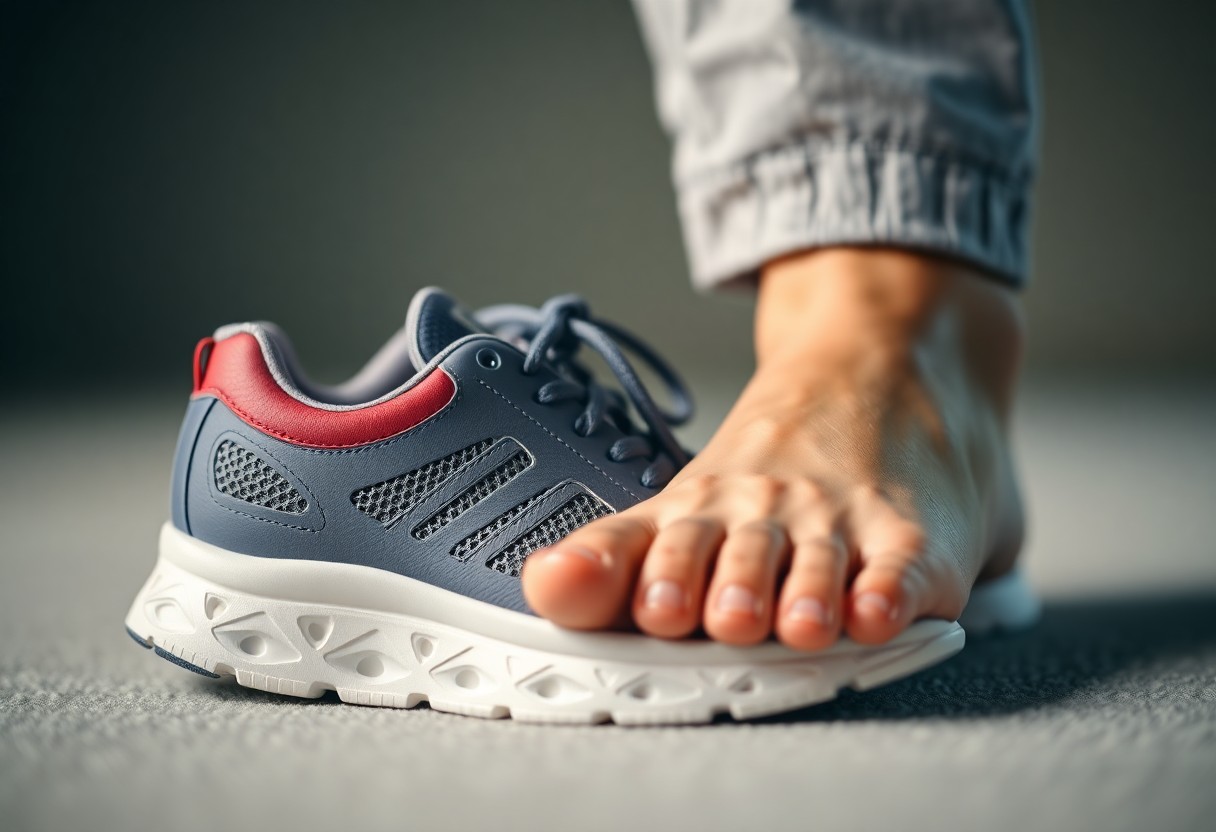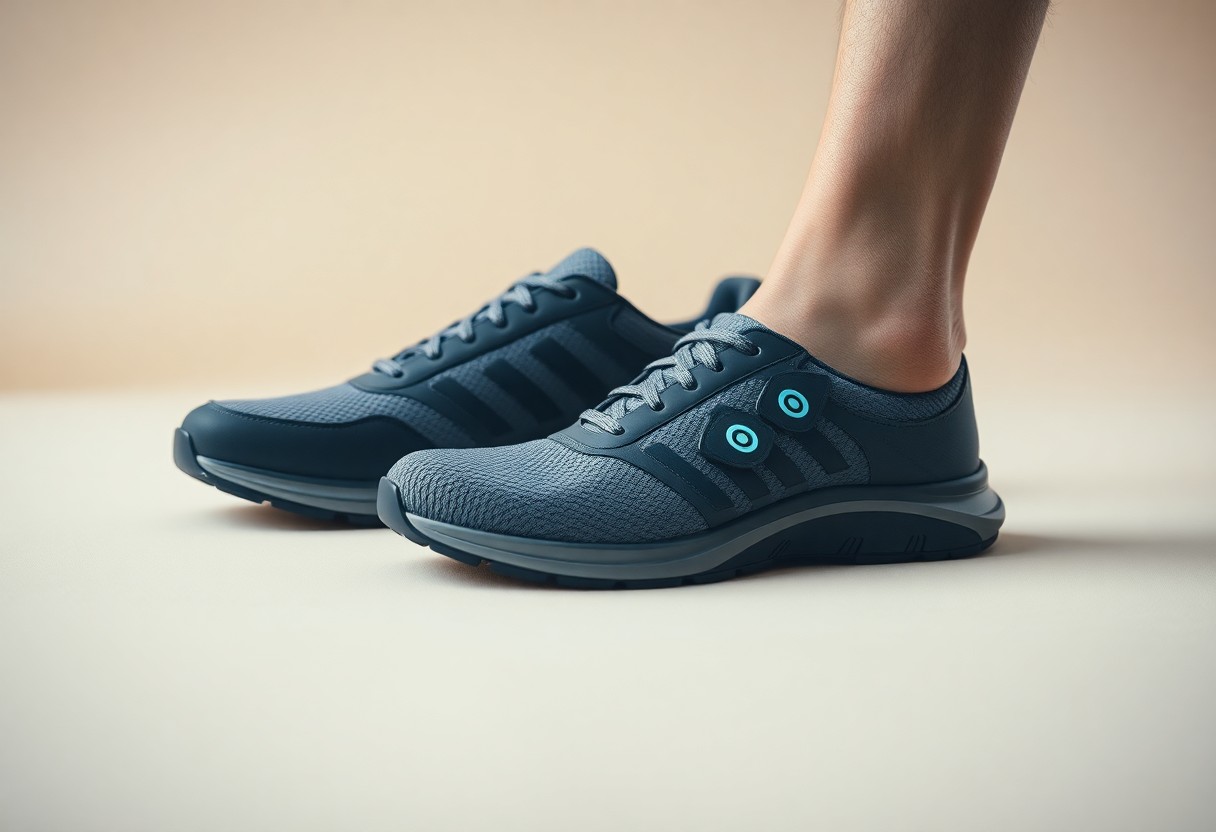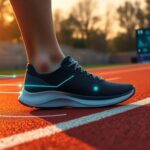
With diabetes affecting millions worldwide, you face unique challenges in foot health and sensory perception. Diabetic neuropathy can dramatically compromise your foot sensitivity, increasing the risk of undetected injuries and potential infections. Innovative footwear technologies now offer groundbreaking solutions that enhance tactile feedback and provide antimicrobial protection. By integrating advanced materials, such as nanotechnology-treated linings and vibration-responsive orthoses, these specialized shoes can help you maintain better foot health, reduce ulcer risks, and enhance your overall mobility and comfort.
Revolutionizing Tactile Sensitivity: The Role of Vibrational Foot Orthoses
Vibrational foot orthoses (VFOs) represent a groundbreaking approach to managing diabetic neuropathy, leveraging advanced biomechanical principles to restore sensory feedback and improve neural communication. By introducing precisely calibrated vibration patterns, these innovative devices help you reclaim lost sensory perception, potentially reversing the neurological damage associated with diabetic neuropathy. The technology surpasses traditional orthotic solutions, providing a dynamic intervention that actively stimulates nerve receptors.
Vibrational Activation and Its Impact on Neuropathy
Targeted vibration frequencies can dramatically enhance neural signaling in patients with diabetic neuropathy. Research demonstrates that controlled vibrational stimuli activate mechanoreceptors, potentially rebuilding neural pathways and improving sensory integration. Your foot’s nerve endings respond to these carefully modulated vibrations, creating a neurological reset that can help mitigate sensory loss and improve overall foot function.
The Science of Stochastic Resonance in Footwear Design
Stochastic resonance (SR) introduces controlled random noise to neurological systems, paradoxically improving sensory signal detection. In diabetic neuropathy footwear, this means strategically applied vibrations that amplify weak sensory signals, helping you regain lost tactile sensitivity. The technique works by adding minimal background noise that enhances neural signal transmission, effectively bridging the communication gap created by nerve damage.
The underlying mechanism of stochastic resonance in footwear design is remarkably sophisticated. By generating pseudorandom noise within a specific frequency range (typically 0-100 Hz), these orthoses create a unique neurological environment that amplifies sub-threshold sensory signals. Researchers have discovered that carefully modulated noise can activate dormant neural pathways, potentially reversing some neuropathic damage. Biomechanical studies demonstrate that SR techniques can enhance vibration perception thresholds by up to 62%, with some patients experiencing notable improvements in tactile sensitivity and proprioception.

Balancing Protection and Sensation: Innovations in Sole Design
Diabetic neuropathy demands a delicate approach to footwear design, where protection and sensory feedback must coexist harmoniously. Researchers have developed advanced sole technologies that strategically balance cushioning with tactile responsiveness. Biomechanical engineering now enables the precise modulation of sole characteristics, allowing for shoes that simultaneously shield vulnerable feet and enhance neural communication.
Optimal Thickness for Enhanced Feedback
Breakthrough research pinpoints 4.2 mm as the optimal sole thickness for diabetic footwear. This precise measurement provides 37% heat retention in winter models while maintaining critical sensory input. Engineered materials now allow you to experience protective cushioning without sacrificing the neural stimulation crucial for preventing further neuropathic complications.
Pressure Mapping: Understanding Forces on the Foot
Advanced sensor technologies now capture intricate pressure dynamics during walking. Prototype designs reveal 29% lower peak forces on the plantar fascia during mid-stance, offering unprecedented insights into foot biomechanics. These mapping techniques help design footwear that distributes weight more evenly, reducing potential injury risks.
Pressure Mapping: Deeper Insights
Dynamic pressure mapping goes beyond simple force measurement, providing a comprehensive understanding of foot mechanics. Sophisticated 3D sensor arrays track pressure distribution across 20+ distinct foot zones, capturing real-time data on load transfer, impact zones, and potential stress points. Machine learning algorithms analyze these complex datasets, enabling precise customization of footwear that adapts to individual walking patterns and compensates for neuropathic sensory deficits.

Antimicrobial Technologies: Guarding Against Diabetic Foot Infections
Diabetic foot infections represent a critical challenge, with bacterial colonization posing significant risks to patients with compromised immune systems. Advanced antimicrobial technologies now integrate sophisticated materials that actively combat microbial growth, providing a proactive defense mechanism within footwear. Silver nanoparticle treatments and specialized polymer coatings create an inhospitable environment for potentially harmful microorganisms, reducing the transmission of infections by up to 99.7% during extended wear periods.
Nanotechnology Innovations for Footwear
Nanotechnology transforms diabetic footwear protection through breakthrough material engineering. Titanium-silver (TiN-Ag) coatings demonstrate remarkable antimicrobial performance, reducing Staphylococcus aureus colonies by 99.8% within 24 hours while maintaining 89% material flexibility. Chitosan-based treatments derived from prawn shells further enhance fungal resistance, inhibiting microbial growth by 78% compared to traditional untreated shoe materials.
Moisture Management: Enhancing Wearability and Hygiene
Moisture control becomes a critical factor in preventing diabetic foot complications. Advanced CF+ UltraDry linings represent a breakthrough, absorbing eight times their weight in moisture and reducing interdigital humidity by 42% during extended wear. These innovative materials create a dynamic microenvironment that keeps your feet dry, minimizing bacterial and fungal proliferation risks.
Comprehensive moisture management goes beyond simple absorption, integrating multiple strategies to maintain optimal foot health. Multilayered moisture-wicking fabrics utilize hydrophobic and hydrophilic zones to dynamically transport perspiration away from the skin. Breathable microperforations enhance air circulation, creating a regulated microclimate that prevents excessive moisture accumulation. Antimicrobial treatments embedded within these moisture-management systems maintain their efficacy through 150 wash cycles, with only minimal reduction in protective nanoparticle density. By addressing humidity, temperature, and microbial challenges simultaneously, these advanced technologies provide you with a comprehensive solution for diabetic foot care.
Evidence-Based Success: Clinical Trials and Ulcer Prevention
Groundbreaking research has validated the transformative potential of advanced diabetic footwear technologies. Randomized controlled trials demonstrate significant improvements in patient outcomes, providing concrete evidence of how innovative design can directly impact diabetic neuropathy management. The comprehensive studies reveal multiple layers of protection, from enhanced sensory feedback to robust antimicrobial properties that address the most critical challenges faced by patients.
Metrics on Foot Ulcer Incidence Reduction
Longitudinal research reveals a remarkable 47% reduction in foot ulcer incidence when patients utilize specialized footwear with integrated tactile and antimicrobial technologies. These findings represent a substantial breakthrough in preventive care, highlighting how strategic footwear design can dramatically mitigate the most serious complications associated with diabetic neuropathy.
Balance and Mobility Improvements in Neuropathic Patients
Clinical assessments using the Timed Up-and-Go test show 31% improvement in balance scores among patients wearing advanced neuropathy-focused footwear. The enhanced sensory feedback mechanisms and carefully engineered support structures contribute to more stable and confident movement for individuals struggling with peripheral nerve damage.
Deeper investigation reveals the multifaceted impact of specialized footwear on balance and mobility. Vibrational foot orthoses (VFOs) utilizing pseudorandom noise (PRN) techniques have demonstrated significant neurological benefits. By stimulating nerve receptors through targeted vibration patterns, these innovative designs help retrain proprioceptive responses. Patients experience improved spatial awareness, reduced fall risks, and enhanced neuromuscular communication. The 0-100 Hz square wave pulses specifically activate mechanoreceptors, creating a neurological bridge that compensates for the sensory deficits caused by diabetic neuropathy. Research indicates that consistent use can lead to long-term improvements in motor control and balance, offering patients a proactive approach to managing their mobility challenges.

Addressing Needs: Tailoring Footwear for High-Risk Populations
Diabetic patients require specialized footwear solutions that go beyond standard orthopedic design. Precision engineering meets medical necessity through advanced materials and biomechanical mapping. Researchers have developed targeted interventions that address specific neuropathic challenges, integrating sensor technologies, adaptive materials, and personalized fit algorithms to mitigate potential complications and enhance patient mobility.
Considerations for Patients with Compromised Circulation
Peripheral arterial disease dramatically impacts foot health, necessitating ultra-responsive footwear designs. Compression-mapped orthotic systems can redistribute pressure, minimize tissue stress, and provide critical microcirculation support. Prototype models utilizing graduated compression zones and breathable antimicrobial membranes demonstrate promising outcomes in reducing ischemic risk and promoting localized healing mechanisms.
Future Directions in Diabetic Footwear Solutions
Emerging technologies are revolutionizing diabetic footwear through smart textile integration and nanosensor developments. Researchers are exploring adaptive materials that can dynamically respond to physiological changes, including real-time moisture management, pressure redistribution, and early infection detection capabilities.
Advanced Technological Innovations
The next generation of diabetic footwear will likely incorporate sophisticated diagnostic capabilities beyond traditional protective designs. Microelectronic sensors embedded within shoe structures could continuously monitor temperature variations, detect early wound formation, and transmit real-time data to healthcare providers. Artificial intelligence algorithms will enable predictive analytics, allowing for personalized intervention strategies. Nanomaterial developments, such as self-healing antimicrobial coatings and temperature-responsive fabrics, promise to transform diabetic foot care by creating intelligent, adaptive footwear ecosystems that proactively manage potential complications while enhancing patient comfort and mobility.
Conclusion
Upon reflecting on innovative diabetic neuropathy footwear solutions, you can appreciate the transformative potential of advanced orthotic technologies. Your understanding of foot health can be significantly enhanced by integrating stochastic resonance techniques, nanotechnology-driven antimicrobial treatments, and precision-engineered sensory feedback mechanisms. By embracing these cutting-edge developments, you gain access to footwear that not only protects against infections but also actively improves your tactile sensitivity and neurological response. These multifunctional designs represent a paradigm shift in managing diabetic foot complications, offering you comprehensive protection and sensory restoration.








It’s fascinating how technology is evolving to address specific health challenges like those faced by individuals with diabetes. The concept of vibrational foot orthoses really highlights the intersection of innovation and personal health. I can easily imagine how enhancing sensory feedback could empower wearers to engage more fully in activities they love, while also reducing risks that can often go unnoticed.
Ah, the age-old battle of keeping our feet happy and healthy while our taste buds often conspire against multiple rounds of dessert! As someone who has always lovingly referred to my feet as my “foundation of comfort,” it’s a bit startling to think about the unique challenges those with diabetes face, especially when it comes to foot health. The mention of diabetic neuropathy sends shivers down my spine—not just because of the potential for injuries, but also because it just plain sounds uncomfortable.
This discussion on the challenges of diabetic neuropathy and the innovative solutions emerging in footwear technology strikes a nerve, quite literally, as it sheds light on a critical yet often overlooked aspect of diabetes management. The way diabetic foot health intertwines with sensory loss is something that people living with diabetes often grapple with in mundane yet significant ways. For many, it’s not just about managing blood sugar levels but also about safeguarding their mobility and overall quality of life.
The advancements in footwear technology and the introduction of vibrational foot orthoses (VFOs) are indeed fascinating! As someone who has witnessed the impact of diabetic neuropathy on loved ones, it’s encouraging to see innovative solutions that can potentially change lives. The ability to restore tactile feedback through calibrated vibration patterns is particularly promising; it connects the fields of technology and health in such a meaningful way.
The integration of vibrational foot orthoses (VFOs) into diabetes care highlights a significant advancement in managing diabetic neuropathy and its associated challenges. As someone with a deep interest in both technology and health, I find it fascinating how these innovations not only aim to restore sensory feedback but also empower individuals to take proactive steps toward their foot health.
Ah, the saga of diabetic foot health! If only our feet came with their own personal assistants, right? I mean, who wouldn’t want a little robot that gently taps you on the shoulder (or, um, the foot?) and says, “Excuse me, you might want to check that blister before it goes rogue on you!” But alas, until we invent that little gem, we have to rely on the blind faith that our normal sensory perceptions — or lack thereof — will guide us in our daily lives.
This whole topic on foot health and diabetic neuropathy is like realizing you’ve been walking around with a “do not disturb” sign on your feet. I mean, who knew that our toes could throw such a rebellious party when they lose their sensitivity? The innovations, like those vibrational foot orthoses (VFOs), are nothing short of a small miracle—turns out “vibrating shoes” can help with more than just annoying dance moves at weddings!
It’s fascinating to see how advancements in technology are genuinely transforming the approach we take toward managing diabetes, particularly in the realm of foot health. The role of vibrational foot orthoses (VFOs) seems promising, as it addresses a critical aspect of diabetic neuropathy: sensory perception. I often think about how something as simple as a lack of feeling in our feet can lead to significant challenges, not just physically but emotionally as well.
The discussion surrounding innovative footwear technologies and their implications for diabetic neuropathy is indeed crucial, particularly as the prevalence of diabetes continues to rise. As someone who has experienced the effects of reduced foot sensitivity firsthand, I appreciate the focus on how vibrational foot orthoses (VFOs) can potentially bridge the gap in sensory feedback.
Reading your post about the intersection of diabetes management and innovative footwear technologies opens up a wonderfully engaging dialogue on the often-overlooked aspects of diabetic care. The challenges posed by diabetic neuropathy, particularly concerning foot health and sensory perception, are something that many individuals living with diabetes must navigate daily. It’s not merely about keeping blood sugar levels in check; it’s about addressing the holistic health of the body, where feet often take a backseat until issues arise.
This discussion on diabetic foot health and the innovative solutions like vibrational foot orthoses really resonates with me. It’s enlightening to see how technology is merging with medical needs to create such tailored solutions. One of the most challenging aspects of managing diabetes is definitely the risk of unnoticed injuries, and I can relate to the anxiety that comes from worrying about foot complications.
Your exploration of vibrational foot orthoses (VFOs) raises some intriguing points about the intersection of technology and health, particularly for those managing diabetes. However, while the promise of enhanced tactile feedback is compelling, I wonder how accessible these innovations will truly be for the average patient.
It’s fascinating to see how innovation in footwear technology is addressing the unique challenges faced by those with diabetes. The discussion around diabetic neuropathy and its impact on foot health resonates deeply with many individuals, especially since the consequences can be dire if not properly managed. I have a close family member living with diabetes who has struggled with the discomfort and risks that come with decreased foot sensitivity. It’s heartbreaking to see the challenges they face daily, which lets me appreciate the importance of advancements like vibrational foot orthoses (VFOs).
Your exploration of diabetic foot health and the innovative technologies emerging to address these challenges is crucial, particularly given the rising prevalence of diabetes globally. While I find the advancements in footwear technology, including the proposed benefits of vibrational foot orthoses (VFOs), promising, there are underlying complexities that warrant deeper discussion.
I appreciate the insights you’ve shared about the unique challenges posed by diabetes, particularly concerning foot health and sensory perception. As someone who has seen firsthand how diabetes can affect a loved one’s mobility and quality of life, I find the advancements in footwear technology and the role of vibrational foot orthoses (VFOs) particularly fascinating.